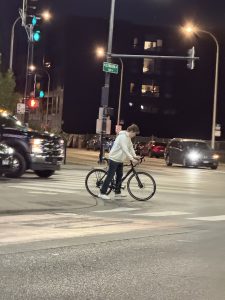As daylight saving time ends, Chicago evenings grow darker earlier—often just as commuters head home. This seasonal change creates a perfect storm for bicycle accidents on Chicago streets. The bike injury lawyers of Zneimer & Zneimer P.C., have represented cyclists injured after dark, many of whom were simply trying to get home safely. Understanding the unique dangers of biking at night—and how motorists can help prevent tragedy—is crucial for everyone sharing the road.
Darkness and Headlight Glare: A Dangerous Combination
With sunset arriving as early as 4:30 p.m. in winter months, even short commutes occur in low-light or dark conditions. Bright headlights from oncoming traffic can momentarily blind motorists, making it difficult to see cyclists riding along the edge of the lane. This effect is especially severe on narrow Chicago streets or when rain, snow, or wet pavement reflects the glare.
For cyclists, visibility is everything. State law requires front white lights and rear red reflectors or lamps at night—but even with lights, a small bike can easily disappear in the glare of high-beam headlights. Motorists should slow down, avoid high beams when other vehicles are present, and scan for movement along curbs, parked cars, and intersections.
Young Cyclists and Inexperience at Night
Chicago’s streets attract many young cyclists and e-scooter riders, especially near college campuses, Lakefront Trail access points, and neighborhoods like Wicker Park and Logan Square. Unfortunately, younger riders often lack experience with night-time traffic. They may not wear reflective gear, may ride without proper lights, or weave unpredictably between lanes or parked cars. Drivers should anticipate these behaviors and allow extra room when passing.
Parents should also remind their teens that riding at night without lights or reflective clothing is not only unsafe—it’s illegal under Illinois law.
Motorists’ Duties: Seeing and Avoiding Cyclists
From a motorist’s point of view, avoiding a collision with a cyclist at night requires active attention and reduced speed. Drivers should:
- Double-check mirrors and blind spots before changing lanes or turning right across a bike lane.
- Avoid distracted driving—even a momentary glance at a phone can hide a small light from a bike.
- Use low beams when other traffic is nearby.
- Expect cyclists in bike lanes or on shared roads, especially near downtown or neighborhood retail areas.
Chicago’s municipal code gives cyclists the same rights to the road as cars, meaning motorists have a legal duty to exercise due care when driving near them.
Dooring at Night: A Common and Costly Mistake
Dooring—when a driver or passenger opens a car door into the path of a cyclist—is a major cause of bike injuries in Chicago. At night, the risk increases dramatically because cyclists are harder to see and interior car lighting reduces outside visibility. Before opening a door, motorists should perform the “Dutch Reach”—using the hand farthest from the door, which forces a shoulder turn toward oncoming traffic. Chicago law makes it illegal to open a vehicle door into moving traffic unless it’s safe to do so.
Turning at Night: Left and Right Turns Require Extra Caution
Many serious nighttime crashes occur when a car turns left across the path of an oncoming cyclist. Because a bike’s single headlight may be small and appear distant, drivers often misjudge speed and distance. Always yield until you are certain the lane is clear.
When making right turns, check mirrors for cyclists riding to your right. A cyclist in the blind spot can easily be struck if the driver turns without checking first. Signal early, check twice, and turn slowly.
Legal Help for Injured Cyclists
If you or a loved one has been injured in a nighttime bicycle accident, contact the Chicago bicycle accident attorneys at Zneimer & Zneimer P.C. Our experienced lawyers investigate every detail—from poor visibility and glare to driver negligence—to help victims recover the compensation they deserve.
Call (773) 516-4100 or visit www.zneimerlaw.com for a free consultation.
 Chicago Accident Lawyer Blog
Chicago Accident Lawyer Blog



